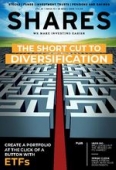Archived article
Please note that tax, investment, pension and ISA rules can change and the information and any views contained in this article may now be inaccurate.
The bestseller from Fundsmith’s boss still packs a punch

Back in the early 1990s, stockbroking firm UBS Phillips & Drew published a controversial research report titled ‘Accounting for Growth’.
The report’s co-authors were Richard Hannah, the shipping and transport analyst, and Terry Smith – who at the time was head of UK company research but is now better known as the founder of Fundsmith, one of the most successful UK fund management firms.
The report examined the rapid rise in profits at several UK companies and asked whether the increases were real or were generated by sleight of hand.
Over 200 companies were analysed and ranked by the number of ‘creative accounting’ techniques they used to enhance profits (known as the ‘blob guide’).
STRIKING A CHORD WITH INVESTORS
The report was voted the best piece of research by institutional investors in 1991, although the companies which scored poorly in it were understandably less than pleased.
The proof is in the pudding however and with just one or two exceptions the companies which ranked the worst duly performed the worst that year.
In 1992 the report was expanded and made into a book so that both institutional and retail investors could see for themselves where to find the relevant information in company accounts to spot these creative accounting techniques.
IF IN DOUBT DON’T OWN THE SHARES
The aim of the book is to prevent investors from losing money, and the advice is simple: if there are any doubts about the accounts, don’t buy the shares.
The examples may be ancient history for today’s investors but that doesn’t mean the lessons are any less valuable.
One of the most striking examples is Polly Peck, a FTSE 100 company with a £1.5bn market value which announced record results on 3 September 1990, had its shares suspended on 20 September 1990 and by 25 October 1990 was in administration.
It turned out that for all its fancy footwork the company was deeply in debt and a large part of its cash was offshore in Northern Cyprus and Turkey, beyond the reach of creditors and shareholders.
With a £1.8bn market value, British & Commonwealth was the 46th largest stock in the FTSE 100 and the second biggest financial behind Prudential (PRU) which meant it ‘fell from an even greater height’ when it went into administration after contingent liabilities sunk its balance sheet.
ROBERT MAXWELL
Probably the most famous – or infamous – case study is the group of companies run by Robert Maxwell.
After Maxwell’s mysterious demise off the Canary Islands in 1991, it was discovered that Mirror Group Newspapers’ bank account had been emptied and £350m was missing from its pension funds.
Also various assets which had been pledged as security against bank loans had actually been sold and the share price had been manipulated in order to avoid margin calls on other bank loans.
Sister company Maxwell Communications Corp filed for Chapter 11 bankruptcy protection in the US after it was discovered that it had net debts of £1.5bn against net assets of just £1bn.
GREEDY IS AS GREEDY DOES
In most cases, companies which use aggressive or ‘creative’ accounting methods will have been using them for years and there may already be an odour of mistrust around them.
Managements which allow or encourage the flattering of earnings, be it through acquisition accounting, capitalising costs, currency mismatching or off balance sheet techniques to name a few examples, are not likely to change their behaviour.
Because profits can be ‘manufactured’, investors should focus instead on cash: as the book says, profits are just a matter of opinion – in fact they are no more than a ‘true and fair view’ by the firm’s auditors – but hard cash is fact.
Last year former fund manager Tim Steer brought out an updated guide on how to avoid companies heading for a fall, which he called ‘The Signs Were There’.
Steer began his City career in 1987 as an analyst at James Capel Ltd (now part of HSBC) before heading up the European small- and mid-cap research team at Merrill Lynch.
In 2001 he helped set up New Star Asset Management before moving to Artemis in 2009 where five years later he was AAA-rated by Citywire as manager of a £4bn long-short UK fund.
Steer says if you spot the slightest accounting shenanigan it is likely to be the tip of the iceberg and the rest of the accounts will be riddled with issues.
One of his major bugbears is capitalising costs, which is an attempt to turn expenses into assets, in turn flattering earnings. This was a strategy routinely used by bust companies like Connaught and is currently utilised by Aston Martin Lagonda (AML), as we have flagged previously.
Other bugbears include adjustments to the value of inventories (for example Patisserie) or acquisitions (Conviviality) and the treatment of receivables and accrued income as assets (Amey, Carillion).
Important information:
These articles are provided by Shares magazine which is published by AJ Bell Media, a part of AJ Bell. Shares is not written by AJ Bell.
Shares is provided for your general information and use and is not a personal recommendation to invest. It is not intended to be relied upon by you in making or not making any investment decisions. The investments referred to in these articles will not be suitable for all investors. If in doubt please seek appropriate independent financial advice.
Investors acting on the information in these articles do so at their own risk and AJ Bell Media and its staff do not accept liability for losses suffered by investors as a result of their investment decisions.

 magazine
magazine









